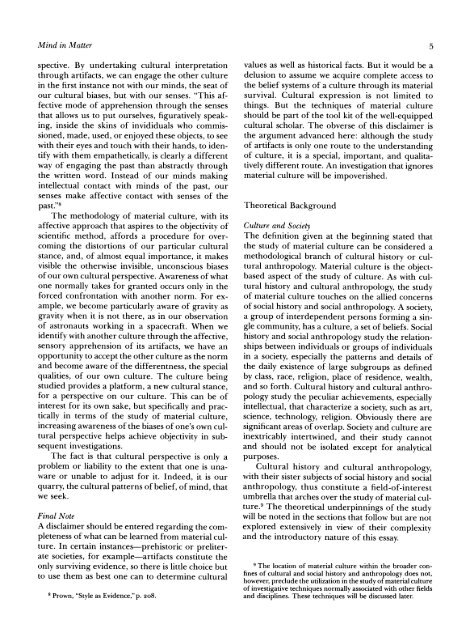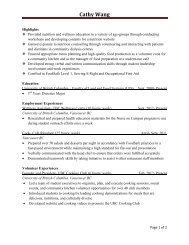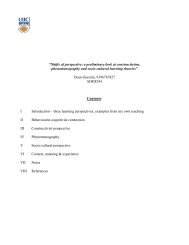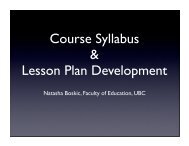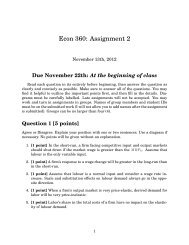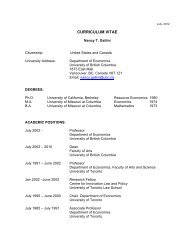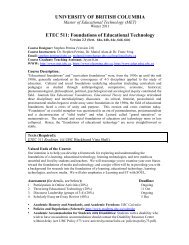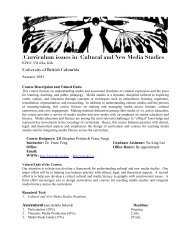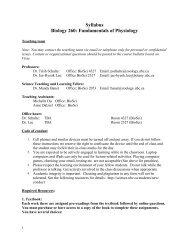Mind in Matter: An Introduction to Material Culture ... - UBC Blogs
Mind in Matter: An Introduction to Material Culture ... - UBC Blogs
Mind in Matter: An Introduction to Material Culture ... - UBC Blogs
Create successful ePaper yourself
Turn your PDF publications into a flip-book with our unique Google optimized e-Paper software.
<strong>M<strong>in</strong>d</strong> <strong>in</strong> <strong>Matter</strong>spective. By undertak<strong>in</strong>g cultural <strong>in</strong>terpretationthrough artifacts, we can engage the other culture<strong>in</strong> the first <strong>in</strong>stance not with our m<strong>in</strong>ds, the seat ofour cultural biases, but with our senses. "This affectivemode of apprehension through the sensesthat allows us <strong>to</strong> put ourselves, figuratively speak<strong>in</strong>g,<strong>in</strong>side the sk<strong>in</strong>s of <strong>in</strong>vididuals who commissioned,made, used, or enjoyed these objects, <strong>to</strong> seewith their eyes and <strong>to</strong>uch with their hands, <strong>to</strong> identifywith them empathetically, is clearly a differentway of engag<strong>in</strong>g the past than abstractly throughthe written word. Instead of our m<strong>in</strong>ds mak<strong>in</strong>g<strong>in</strong>tellectual contact with m<strong>in</strong>ds of the past, oursenses make affective contact with senses of thepast."8The methodology of material culture, with itsaffective approach that aspires <strong>to</strong> the objectivity ofscientific method, affords a procedure for overcom<strong>in</strong>gthe dis<strong>to</strong>rtions of our particular culturalstance, and, of almost equal importance, it makesvisible the otherwise <strong>in</strong>visible, unconscious biasesof our own cultural perspective. Awareness of wha<strong>to</strong>ne normally takes for granted occurs only <strong>in</strong> theforced confrontation with another norm. For example,we become particularly aware of gravity asgravity when it is not there, as <strong>in</strong> our observationof astronauts work<strong>in</strong>g <strong>in</strong> a spacecraft. When weidentify with another culture through the affective,sensory apprehension of its artifacts, we have anopportunity <strong>to</strong> accept the other culture as the normand become aware of the differentness, the specialqualities, of our own culture. The culture be<strong>in</strong>gstudied provides a platform, a new cultural stance,for a perspective on our culture. This can be of<strong>in</strong>terest for its own sake, but specifically and practically<strong>in</strong> terms of the study of material culture,<strong>in</strong>creas<strong>in</strong>g awareness of the biases of one's own culturalperspective helps achieve objectivity <strong>in</strong> subsequent<strong>in</strong>vestigations.The fact is that cultural perspective is only aproblem or liability <strong>to</strong> the extent that one is unawareor unable <strong>to</strong> adjust for it. Indeed, it is ourquarry, the cultural patterns of belief, of m<strong>in</strong>d, thatwe seek.F<strong>in</strong>al NoteA disclaimer should be entered regard<strong>in</strong>g the completenessof what can be learned from material culture.In certa<strong>in</strong> <strong>in</strong>stances-prehis<strong>to</strong>ric or preliteratesocieties, for example-artifacts constitute theonly surviv<strong>in</strong>g evidence, so there is little choice but<strong>to</strong> use them as best one can <strong>to</strong> determ<strong>in</strong>e cultural8Prown, "Style as Evidence," p. 208.values as well as his<strong>to</strong>rical facts. But it would be adelusion <strong>to</strong> assume we acquire complete access <strong>to</strong>the belief systems of a culture through its materialsurvival. Cultural expression is not limited <strong>to</strong>th<strong>in</strong>gs. But the techniques of material cultureshould be part of the <strong>to</strong>ol kit of the well-equippedcultural scholar. The obverse of this disclaimer isthe argument advanced here: although the studyof artifacts is only one route <strong>to</strong> the understand<strong>in</strong>gof culture, it is a special, important, and qualitativelydifferent route. <strong>An</strong> <strong>in</strong>vestigation that ignoresmaterial culture will be impoverished.Theoretical Background<strong>Culture</strong> and SocietyThe def<strong>in</strong>ition given at the beg<strong>in</strong>n<strong>in</strong>g stated thatthe study of material culture can be considered amethodological branch of cultural his<strong>to</strong>ry or culturalanthropology. <strong>Material</strong> culture is the objectbasedaspect of the study of culture. As with culturalhis<strong>to</strong>ry and cultural anthropology, the studyof material culture <strong>to</strong>uches on the allied concernsof social his<strong>to</strong>ry and social anthropology. A society,a group of <strong>in</strong>terdependent persons form<strong>in</strong>g a s<strong>in</strong>glecommunity, has a culture, a set of beliefs. Socialhis<strong>to</strong>ry and social anthropology study the relationshipsbetween <strong>in</strong>dividuals or groups of <strong>in</strong>dividuals<strong>in</strong> a society, especially the patterns and details ofthe daily existence of large subgroups as def<strong>in</strong>edby class, race, religion, place of residence, wealth,and so forth. Cultural his<strong>to</strong>ry and cultural anthropologystudy the peculiar achievements, especially<strong>in</strong>tellectual, that characterize a society, such as art,science, technology, religion. Obviously there aresignificant areas of overlap. Society and culture are<strong>in</strong>extricably <strong>in</strong>tertw<strong>in</strong>ed, and their study cannotand should not be isolated except for analyticalpurposes.Cultural his<strong>to</strong>ry and cultural anthropology,with their sister subjects of social his<strong>to</strong>ry and socialanthropology, thus constitute a field-of-<strong>in</strong>terestumbrella that arches over the study of material culture.9The theoretical underp<strong>in</strong>n<strong>in</strong>gs of the studywill be noted <strong>in</strong> the sections that follow but are notexplored extensively <strong>in</strong> view of their complexityand the <strong>in</strong>troduc<strong>to</strong>ry nature of this essay.9 The location of material culture with<strong>in</strong> the broader conf<strong>in</strong>esof cultural and social his<strong>to</strong>ry and anthropology does not,however, preclude the utilization <strong>in</strong> the study of material cultureof <strong>in</strong>vestigative techniques normally associated with other fieldsand discipl<strong>in</strong>es. These techniques will be discussed later.5


